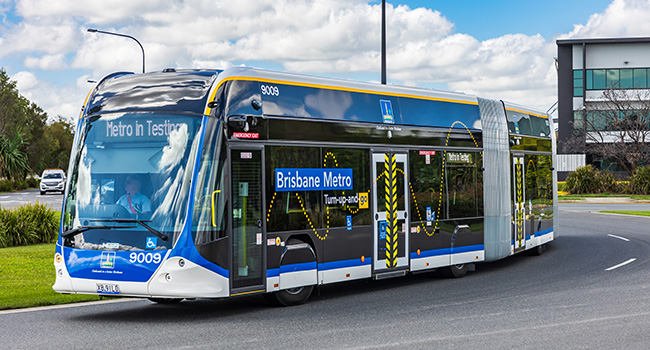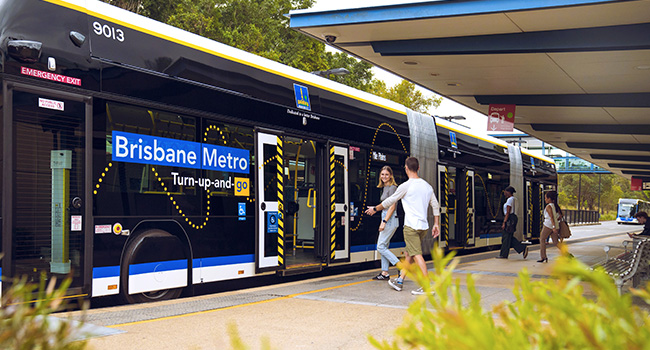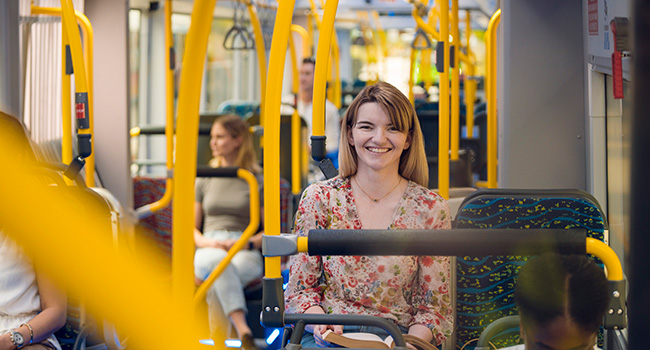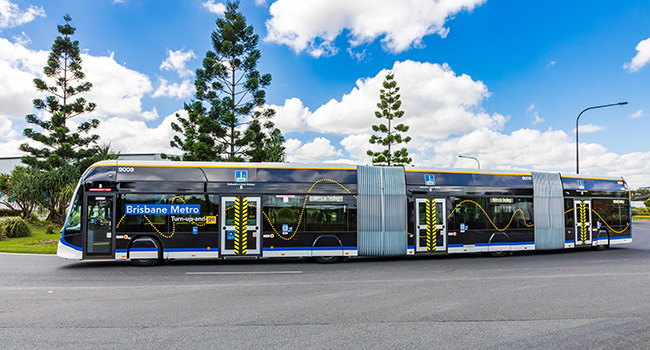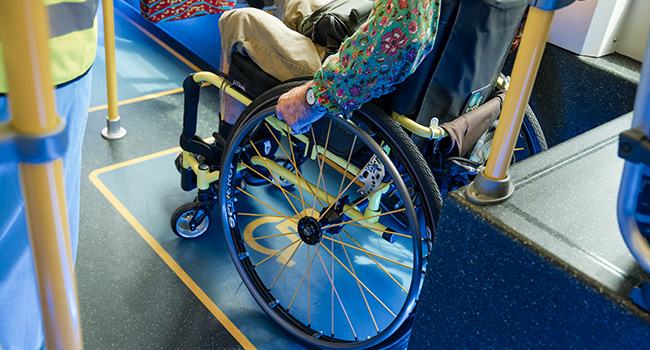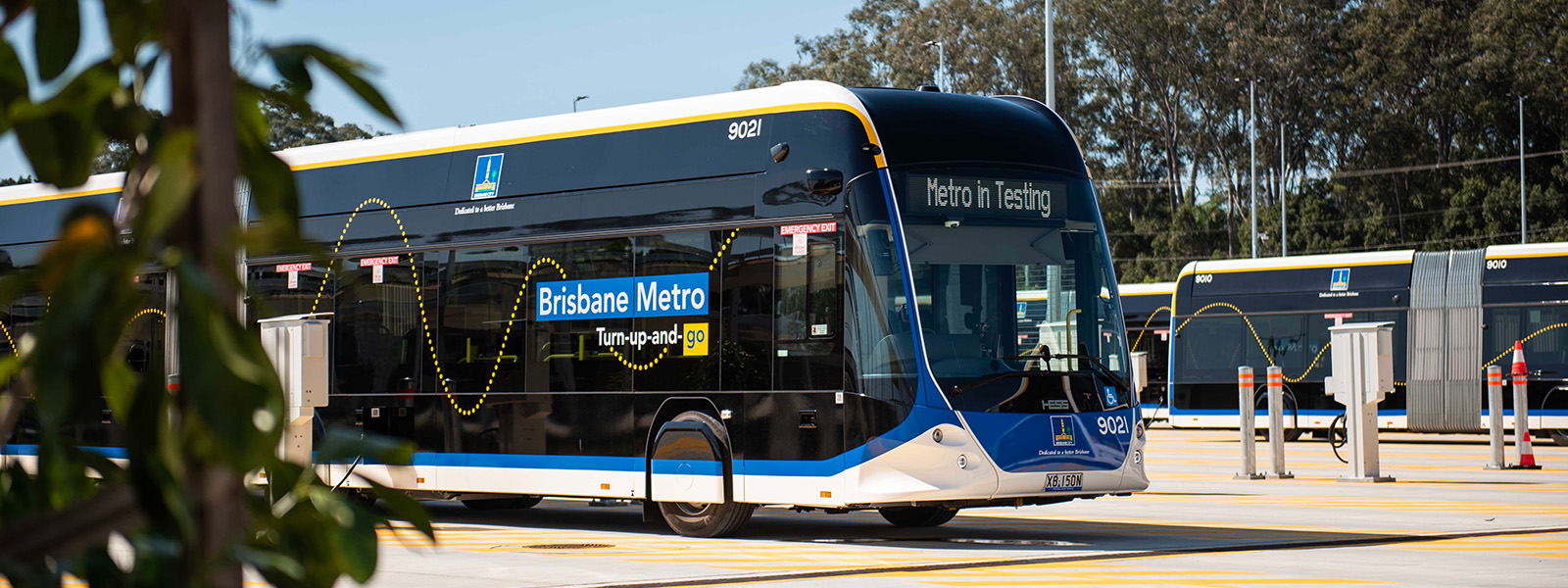
Metros

As part of Brisbane Metro, Brisbane City Council is introducing a new fleet of high-frequency, high‑capacity electric metros, which will operate along Brisbane's dedicated busways, as part of a better planned network.
Council is working with world-leading vehicle manufacturer HESS, electric infrastructure experts Hitachi Energy and leading manufacturer Volgren to deliver the metro fleet and charging infrastructure.
Following the successful trial of the pilot metro, Council has placed the order for the initial fleet of metros, which are progressively arriving ahead of operations.
You can also watch this video on Council's YouTube channel.
TURN-UP-AND-GO SERVICES
FULLy electric operation
OPERATING ALONG DEDICATED BUSWAYS
CAPACITY FOR 150 PASSENGERS
Metro features
Metros include the high-quality and high-capacity features of light rail while avoiding the need for tracks, overhead line equipment and infrastructure by utilising our existing busway. With a spacious bi-articulated design, metros comfortably transport 150 passengers and 170 passengers in event mode, enabling greater capacity on Brisbane’s public transport network.
Through a unique co-design process with the accessibility sector, metros exceed compliance with relevant disability standards and guidelines.
Key achievements include increasing the number and size of mobility aid bays and the number of priority seating areas, making this Australia’s leading accessible public transport option.
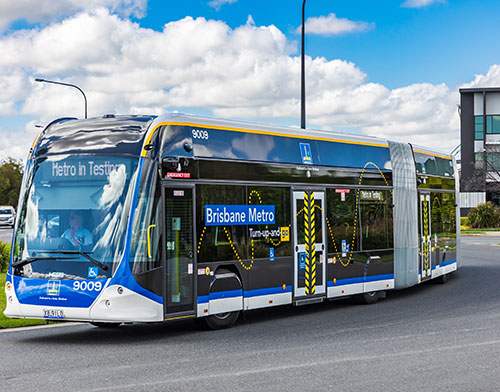
Passenger features
Passenger features of the metro include:
- comfortable capacity for 150 passengers and 170 in event mode
- three large double doors for efficient all door boarding
- passenger information displays and visual route information
- in-built USB A and C charging points and on-board Wi‑Fi
- configurable LED lighting and an interior illuminated ceiling
- panoramic windows throughout.
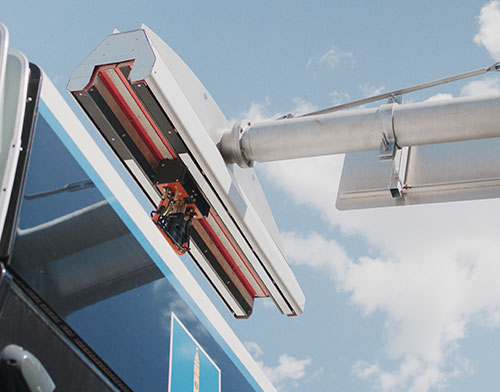
Technology features
Technology features of the metro include:
- battery electric operation
- zero tailpipe emissions
- quiet operation, achieving significant reduction in noise pollution
- on-board telematics system providing real‑time travel information
- driver assistive technologies to support safe operations
- two of four axels propelled by electric motors for front and rear wheel steering
- flash charging in just over six minutes at the end of route
- a regenerative braking system.
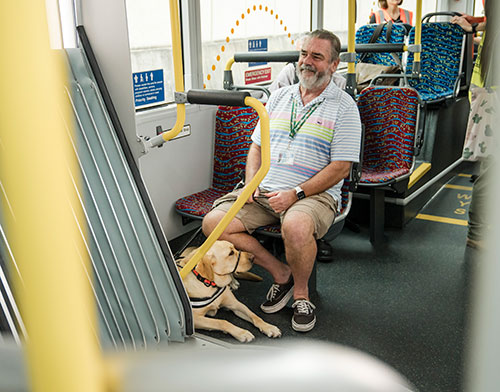
Accessibility features
Accessibility features of the metro include:
- three large mobility aid bays in the first passenger compartment
- automated on-request ramp access at the first passenger door
- low-floor design from front to rear for accessible boarding
- 10 priority seats
- next stop audio and hearing loops in all compartments.
Accessibility and customer features
The onboard metro experience is different to a regular bus. To support customers, we've developed a metro fact sheet and video highlighting onboard accessibility and customer features.
The metro design has been informed by the accessibility sector to help deliver a vehicle that better reflects the diverse needs of our community.
Video transcript
Brisbane City Council is delivering the turn-up-and-go Brisbane Metro, a new fleet of electric, high‑capacity vehicles.
We’ve developed this video to highlight the on board accessibility and customer features, to support you to travel with confidence.
If you’re boarding this vehicle for the first time, there are a number of key things you need to know.
The metros are 24.4 metres long, approximately double the length of a standard bus.
There are three customer compartments, with all door boarding available at the first, middle and rear compartments.
For customers with wheelchairs, prams or personal mobility devices, three large mobility bays are located in the first compartment.
There is also a separated driver cabin, just before the first compartment. This means how you communicate with a driver is different to a regular bus.
To catch a metro, you will still need to hail the service, or use the help phone on the platform to request the service.
Once the vehicle stops at the platform, all doors will open. Please wait until other customers have exited the vehicle before boarding, and then tapping on with your go card.
Customers with mobility requirements are encouraged to board at the first compartment door. It’s important to note, customers with a pram or mobility device will not be able to move between compartments.
All metro vehicles feature an automatic ramp in the first compartment, which can be deployed upon request.
To request the ramp, press the blue ramp request button located on the left panel of the first compartment door.
Once the ramp is requested, an audio announcement will alert you to move back, to allow the ramp to be deployed.
Ramp requested, please move back. Ramp is being deployed.
Before the ramp is deployed, the metro will lower – allowing for smoother boarding.
Once the ramp is fully extended, the doors will open, allowing you to board the metro.
All vehicles are fitted with a manual ramp. If your preference is to board using a manual ramp, please use the help phone on the platform. If you are on board the metro, you can use a help point to communicate directly to the driver to request the manual ramp.
The metro vehicles can comfortably carry 150 customers. There are 64 seats on board and space for standing room.
Hand rails and grab rails are positioned around seating and standing areas.
The first compartment has three large mobility bay areas, with eight blue flip-seats. There is also a number of support features, including railings, padded back rests and passive restraint handles.
Throughout the vehicle, there are 10 red priority seats and 46 blue seats, including a combination of floor level and raised seats.
The vehicle has a low floor design with ground level LED lighting from front to rear to support customers as they move through the vehicle.
There are 6 large screens located throughout the vehicle, with real-time journey information including next stop and arrival times. They will also display if the next stop or ramp request button has been activated.
There are 6 small LED screens throughout the vehicle, with scrolling next stop information.
Audio announcements will play throughout the journey to notify customers of the next stop.
Customers with hearing devices can connect to the on board hearing loop throughout the vehicle.
All buttons and information signs include braille and tactile features.
To request the next stop, press the red next stop button.
Next stop buttons are located throughout the vehicle. When a next stop button is pressed, a beep sound will play.
you require the automatic ramp to exit the vehicle, press the blue ramp request button.
There are four automatic ramp request buttons located in the first compartment in each mobility bay and the red priority seats.
When a ramp request button is pressed, an audio announcement will confirm that the ramp will deploy at the next stop.
Should you require support during your journey, there are six help points located throughout the vehicle.
Help points include a two-way speaker and camera to provide direct communication between you and the driver. To call the driver, press the red button and hold for three seconds.
The three compartments are connected by two articulation points. You may stand in this area while the vehicle is moving.
We encourage you to take care in this area, as the floor of the articulation joint will rotate as the vehicle moves.
There are in-built USB charging points throughout the vehicle as well as on-board Wi-Fi for you to use.
We look forward to welcoming you on board.
You can also watch this video on Council's YouTube channel.
Metro charging strategy
Metros are battery electric and require charging infrastructure to operate. The charging strategy chosen for Brisbane Metro will strike the balance between battery size and life, infrastructure impact and operational efficiency. There will be two types of charging equipment used to charge the metros: fast charging (Grid‑eMotion™) and CCS2 plug-in slow chargers.
Key features and benefits
15 x 600 kW fast charging at end of route locations
Fast charging in under six minutes
Fast charging is 85 times faster than general home electric vehicle charging
60 x 50 kW slow chargers at the metro depot
Slow charging supports battery conditioning
Charging infrastructure
The fast charging system will be the first of its kind in Australia and can charge a metro in just over six minutes at the end of route locations. Fast charging will be delivered using overhead pantograph infrastructure. A pantograph is the moving equipment that autonomously connects to a charging point from the metro roof charging equipment.
Slow chargers will be used to charge the metros at the metro depot. Slow charging increases the metros battery lifespan and optimises energy consumption from Brisbane’s energy grid during off-peak periods. A power load management system controls the slow charging at the metro depot and optimises the current draw from the grid to moderate peak loads.
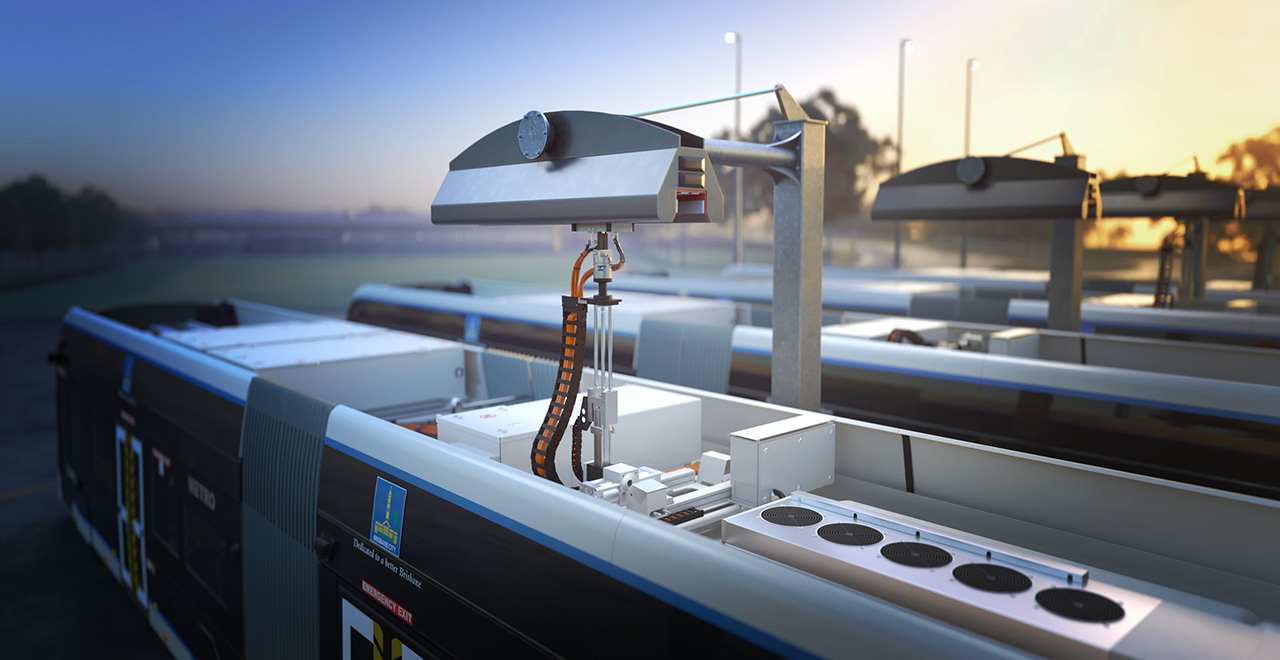
Metro charging infrastructure has been constructed and installed at the following locations:
- Herston: An end of route fast charging facility and driver layover area has been constructed at Ernie’s Roundabout within the existing bus layover area.
- Petrie Terrace: An end of route fast charging facility for metros has been constructed in the Inner Northern Busway adjacent to Countess Street.
- The University of Queensland: UQ Lakes station has been upgraded as well as providing end of route fast charging and layover area for metros.
- Rochedale: The newly-built metro depot houses five fast chargers, as well as 60 slow chargers, and their supporting charging infrastructure.
Watch our video on pilot metro charger trials at Countess Street on Council's YouTube channel.
